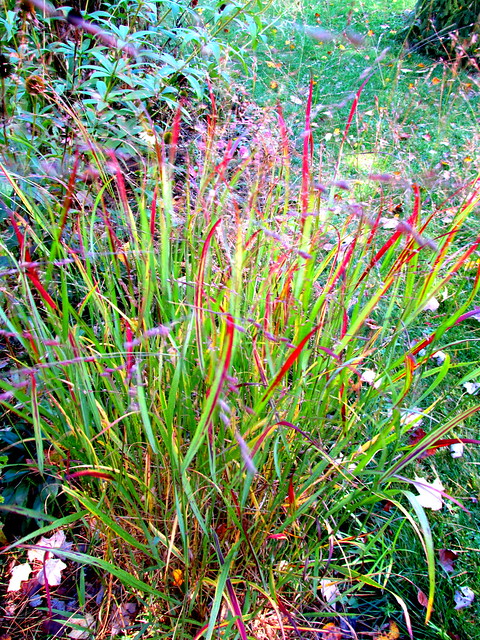Native Plant Profile: Switchgrass (Panicum virgatum)
Switchgrass (Panicum virgatum) is a native, warm season grass that is an excellent replacement for invasive Chinese silvergrass (Miscanthus sinensis). This large, bunching grass grows 3-7 feet high and has a 2-3 foot spread. In addition, its extensive root system grows 5-6 feet deep, making it a great plant to assist with stabilizing banks. The roots also help it to tolerate droughts and floods too!
Switchgrass grows from a cluster of rhizomes. It is an early maturing warm season grass that begins growth in April. Switchgrass can be distinguished from other warm season grasses by the white patch of hairs found where the leaf attaches to the stem. Often, it flowers and fruits in late May through early June. The open panicles of flowers are wind pollinated and give way to tiny rose-tinged seeds. Species of several songbirds have been found to consume the seeds.
Switchgrass can be found growing wild throughout much of Maryland, except for some areas in the western part of the state. It tolerates dry to moderately wet sites and prefers to grow in full sun conditions. If planted in partially shaded and/or nutrient rich soils, the clumps tend to fall over so staking may be required. Switchgrass can thrive in rain gardens and can tolerate areas under black walnut trees too. In the right conditions, switchgrass can self-seed and spread. Therefore, it is important to keep an eye on the plants to prevent them from taking over.
Switchgrass provides food and shelter for a number of local wildlife. Patches of switchgrass, along with other meadow plants, can provide food and cover for upland game species, such as rabbit and quail. Switchgrass is a host plant for the many species of butterflies including the Hobomok Skipper, Delaware Skipper, Leonard’s Skipper, and Northern Broken-Dash. The thick clumps can provide shelter in winter. Therefore, it is recommended that switchgrass stalks aren’t cut back until early spring when new growth appears.
A variety of switchgrass cultivars can be found in the nursery trade. A few of these cultivars include:
- Cloud Nine – looser clump; tall and deep gold fall color
- Heavy Metal – grows to 5 feet; upright growth and dramatic blue foliage
- Northwind – tight and upright growth; good as a vertical accent
- Shenandoah – 2-3 feet height with dramatic fall foliage
References:
Illinois Wildflowers. Switchgrass. https://www.illinoiswildflowers.info/grasses/plants/switchgrass.htm Accessed September 21, 2020.
USDA, NRCS. 2020. The PLANTS Database (https://plants.usda.gov/factsheet/pdf/fs_pavi2.pdf). National Plant Data Team, Greensboro, NC 27401-4901 USA. Accessed September 21, 2020.
Happy Fall!
Spending more time at home means I’m spending more time in the backyard. I have been in awe at the sights I have missed over the years. Lately, I have been watching the backyard monarchs as if they were my own children! As the days get shorter, here are a few things to consider this time of year:
I’m also excited to announce the new Wild Acres public events page which will feature upcoming webinars sponsored by the Wildlife and Heritage Service. In addition, the Gardening for Pollinators webinar is now available on-demand. HabiChat subscribers will receive webinar updates as they are scheduled.
Furthermore, if you are in need of trees and shrubs for conservation or lumber, check out the Maryland State Tree Nursery which will soon be accepting orders for Spring 2021.
In this issue, you can learn about the lovely black and yellow garden spiders which can be seen this time of year, as well as information on the vigorous, native switchgrass. Additional articles include information on the importance of warm season grasses and why leaving flower stems up through the winter helps pollinators.
Happy Habitats,
Kerry Wixted
Click here to have HabiChat—the quarterly backyard wildlife habitat newsletter from the Wild Acres program—delivered right to your inbox!
In this Issue
Native Animal Profile: Black and Yellow Garden Spider
Warm Season Grasses for Wildlife
Creating Habitat for Stem-Nesting Bees




 1-888-373-7888
1-888-373-7888 233733
233733